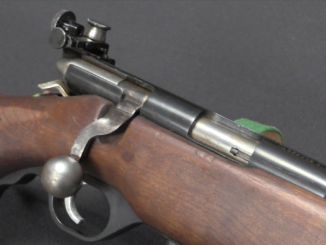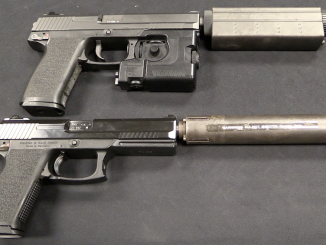In 1977, Arcadia Machine & Tool introduced the Hardballer, the first commercial stainless steel 1911. Stainless steel was a hot commodity, although there were some initial teething issues with slide/frame galling. Eventually, AMT introduced a number of additional 1911 models, including the Javelina – a 10mm Auto model available in standard Government length as well as the 7 inch “Hunter” alongside that we have here today. The Javelina was only made for a couple years in the early 1990s, before AMT had financial problems and the market for the 10mm cartridge lost its initial intensity. As best I can tell, about 2000 Javelinas were made between both barrel lengths.
I was rather impressed with how the gun handled when fired; it was more controllable than I had anticipated. And the 10mm projectile made a very persuasive statement on the plates! Unfortunately, it had a failure to feed about every 10-15 rounds. That was not a surprise to me, as AMT’s reputation is not all that good.




The AMT Longslide .45 ACP is also a 7″ bbl, and is compatible w/ SARCO’s 16″ bbl if you want to throw hot .45 Supers out of a 16″ bbl & have a heavier slide than standard.
I really wonder if you’d have gotten better results if you’d used a more modern 10x25mm Norma mag from Wilson or summat.
Briefly owned a Hardballer back in the heyday. Made the mistake of trying to shoot some steelcase in it:
. dowel
. mallet
. trade-in
Given a choice, I would probably go for the M9A1 and dump this over-power piece in a drawer. At least the former works so long as it is given a proper magazine and good ammunition, and so long as it is not dunked in mud. I could be wrong.
I was told NEVER to put a round in the chamber of a 1911 and drop the slide, it can damage the extractor. Always load from the magazine!
Especially when your 1911 has a poorly made, cast extractor, like AMTs…
That is excellent advice. I have the 7″ Javelina Hunter and have put over 1500 handloads (12.7 grains of Blue Dot pushing a 155-grain bullet) through it without a failure to feed or extract. No signs of excessive pressure either. One of the nicest acquisitions I have made.
I have had a stainless AMT Backup in .380 for many years. It has never malfunctioned with ball or any of the hot defense loads I’ve tried in it. My only gripe is that it is a bitch to take down for cleaning. I took it to a gunsmith twice and replaced the tight roll pin and it didn’t help. I vowed never to try stripping it again, so that means I will never shoot it much any more. A pity. It’s a nice little gun otherwise.
A video on galling would be interesting. Maybe several- what galling is, how it was discovered, what has been done about it, its effects on various stainless gun designs and production, and what guns still out there are subject to it.
Here is a interesting video I found about galling. https://www.youtube.com/watch?v=lnWAehmLhxQ
The problem is not in the material, but in the technology.
Today’s manufacturers are stubbornly reluctant to understand that aerospace technologies such as precision casting or MIM require an aerospace culture of production.
They are trying to reduce manufacturing costs by applying new technologies to older structures that are designed for a different manufacturing method.
They are not ready to pay staff like in NASA, and then they are surprised that the quality of parts is not the same as in Space Shuttle.
Hand-reworking parts is costly, and this destroys profits…
Therefore, the details remain “slightly crooked”, and users swear and are forced to use a “lifetime warranty”.
Those of them who were lucky enough to survive to take advantage of this guarantee… ;-(
“(…)reduce manufacturing costs(…)”
If you need 1911 but faster in production, see 2nd image from top here: https://laststandonzombieisland.com/tag/brastil-1911/
I think the step in the barrel is to accommodate the tilt with the bushing being 2″ further forward than in the original design.